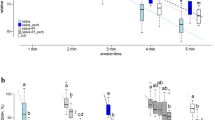Abstract
Acquired salivary pellicle is a thin protein-rich film formed by the adsorption of saliva onto teeth. It plays important roles in lubrication during mastication and protecting the teeth from chemical attack. Pellicle can become colonized by bacteria to form dental plaque which can lead to dental caries if the bacteria are acidogenic. Abrasive polishing with a dentrifice is used periodically to remove the pellicle from teeth. Pellicle can interact with dietary polyphenolic compounds (tannins) to create extrinsic stains on the tooth surface. The staining can modify the pellicle’s mechanical properties and change its morphology resulting in a “squeaky” feeling when the tongue is rubbed over the teeth. Atomic force microscopy imaging and nanoscale mechanical measurements show that unstained pellicle has a dense undulating morphology and is a surprisingly stiff, viscoelastic solid. In contrast, tannin-stained pellicle has fewer but larger surface undulations and exhibits substantial viscous creep.
Similar content being viewed by others
References
M. Hannig: The protective nature of the salivary pellicle. Int. Dent. J. 52, (Suppl. 2), 417 (2002).
M. Hannig: Ultrastructural investigation of pellicle morphogenesis at two different intraoral sites during a 24-h period. Clin. Oral Investig. 3, 88 (1999).
M. Hannig, S. Herzog, S.F. Willigeroth, R. Zimehl: Atomic force microscopy study of salivary pellicles formed on enamel and glass in vivo. Colloid Polym. Sci. 279, 479 (2001).
A. Watts, M. Addy: Tooth discolouration and staining: A review of the literature. Br. Dent. J. 190, 309 (2001).
S.A. Nathoo: The chemistry and mechanisms of extrinsic and intrinsic discoloration. J. Am. Dent. Assoc. 128, 6, Suppl. S, (1997).
L. Ness, D. Rosekrans, J.F. Welford: An epidemiological study of factors affecting extrinsic staining of teeth in an english population. Community Dent. Oral Epidemiol. 5, 55 (1977).
B.M. Eley: Antibacterial agents in the control of supragingival plaque—A review. Br. Dent. J. 186, 286 (1999).
Annual New Product Pacesetters Report (Information Resources, Inc., Chicago, IL, 2005).
W.B. Clark, L.L. Bammann, R.J. Gibbons: Comparative estimates of bacterial affinities and adsorption sites on hydroxyapatite surfaces. Infect. Immun. 19, 846 (1978).
J.H. Kinney, M. Balooch, S.J. Marshall, G.W. Marshall Jr. T.P. Weihs: Hardness and Young’s modulus of human peritubular and intertubular dentine. Arch. Oral Biol. 41, 9 (1996).
L. Angker, M.V. Swain, N. Kilpatrick: Micro-mechanical characterization of the properties of primary tooth dentine. J. Dent. 31, 261 (2003).
M. Finke, J.A. Hughes, D.M. Parker, K.D. Jandt: Mechanical properties of in situ demineralized human enamel measured by AFM nanoindentation. Surf. Sci. 491, 456 (2001).
J.L. Cuy, A.B. Mann, K.J. Livi, M.F. Teaford, T.P. Weihs: Nanoindentation mapping of the mechanical properties of human molar tooth enamel. Arch. Oral Biol. 47, 281 (2002).
H.S. Kim, D.D. Miller: Proline-rich proteins moderate the inhibitory effect of tea on iron absorption in rats. J. Nutr. 135, 532 (2005).
J.B. Pethica, R. Hutchings, W.C. Oliver: Hardness measurement at penetration depths as small as 20 nm. Philos. Mag. A 48, 593 (1983).
W.C. Oliver, G.M. Pharr: An improved technique for determining hardness and elastic modulus using load and displacement sensing indentation experiments. J. Mater. Res. 7, 1564 (1992).
J.L. Loubet, W.C. Oliver, B.N. Lucas: Measurement of the loss tangent of low-density polyethylene with a nanoindentation technique. J. Mater. Res. 15, 1195 (2000).
J.B. Pethica and W.C. Oliver: Mechanical properties of nanometer volumes of material: Use of the elastic response of small area indentations, in Thin Films: Stresses and Mechanical Properties, edited by J.C. Bravman, W.D. Nix, D.M. Barnett, and D.A. Smith (Mater. Res. Soc. Symp. Proc. 130, Pittsburgh, PA, 1989), pp. 13–23.
S.A.S Asif, K.J. Wahl, R.J. Colton: Nanoindentation and contact stiffness measurement using force modulation with a capacitive load-displacement transducer. Rev. Sci. Instrum. 70, 2408 (1999).
S.A.S Asif, K.J. Wahl, R.J. Colton, O.L. Warren: Quantitative imaging of nanoscale mechanical properties using hybrid nanoindentation and force modulation. J. Appl. Phys. 90, 1192 (2001).
K.L. Johnson: Contact Mechanics (Cambridge University Press, Cambridge, UK, 1985), pp. 125–129.
S.V. Dorozhkin, M. Epple: Biological and medical significance of calcium phosphates. Angew. Chem., Int. Ed. 41, 3130 (2002).
A. Bennick, M. Cannon: Quantitative study of the interaction of salivary acidic proline-rich proteins with hydroxyapatite. Caries Res. 12, 159 (1978).
Y. Yao, J. Grogan, M. Zehnder, U. Lendenmann, B. Nam, Z. Wu, C.E. Costello, F.G. Oppenheim: Compositional analysis of human acquired enamel pellicle by mass spectrometry. Arch. Oral Bio. 46, 293 (2001).
M. Naczk, D. Oickle, D. Pink, F. Shahidi: Protein precipitating capacity of crude canola tannins: Effect of pH, tannin and protein concentrations. J. Agric. Food Chem. 44, 2144 (1996).
G. Luck, H. Liao, N.J. Murray, H.R. Grimmer, E.E. Warminski, M.P. Williamson, T.H. Lilley, E. Haslam: Polyphenols, astringency and proline-rich proteins. Phytochemistry 37, 357 (1994).
L.H. Meyer: Food Chemistry (Reinhold Book Corporation, New York, 1960), pp. 97–100.
M. McDonald, I. Mila, A. Scalbert: Precipitation of metal ions by plant polyphenols: Optimal conditions and origin of precipitation. J. Agric. Food Chem. 44, 599 (1996).
Physics of Sliding Friction, edited by B.N.J Persson and E. Tosatti (Kluwer, Dordrecht, The Netherlands, 1996).
M.G. Jorgensen, W.B. Carroll: Incidence of tooth sensitivity after home whitening treatment. J. Am. Dent. Assoc. 133, 1076 (2002).
I. Lewinstein, Z. Hirschfeld, A. Stabholz, I. Rotstein: Effect of hydrogen-peroxide and sodium perborate on the microhardness of human enamel and dentin. J. Endodont. 20, 61 (1994).
Author information
Authors and Affiliations
Corresponding author
Additional information
This author was an editor of this focus issue during the review and decision stage. For the JMR policy on review and publication of manuscripts authored by editors, please refer to http://www.mrs.org/publications/jmr/policy.html.
Rights and permissions
About this article
Cite this article
Dickinson, M.E., Mann, A.B. Nanomechanics and morphology of salivary pellicle. Journal of Materials Research 21, 1996–2002 (2006). https://doi.org/10.1557/jmr.2006.0248
Received:
Accepted:
Published:
Issue Date:
DOI: https://doi.org/10.1557/jmr.2006.0248




